What your birthstone means, according to science

Geology rocks!
“Nobility, without virtue, is a fine setting without a gem.” –Jane Porter
There are plenty of people out there who’ll give you a rundown of what your birthstone means, where a tradition of naturally occurring minerals are correlated with your birth month, dating back to ancient times. Like all precious stones, they were alleged to bring luck, health and prosperity, with each month having a subset of what areas of life one could expect to find “richness” in. Yet science has a different explanation for what your birthstone actually means; let’s go through all 12 below!

January (Garnet): alleged to bring richness is friendship and to enhance trustworthiness, the garnet is actually a silicate mineral that can form from an impressive array of minerals, which includes combinations of magnesium, calcium, manganese or iron along with chromium, iron or aluminum in a cubic or rhombic dodecahedral structure. Given the variety of possibilities, garnets can be red, orange, green or even (rarely) blue in color. Garnets, based on their origin, can help us measure the temperature and pressure history of the formation of igneous and metamorphic rocks.
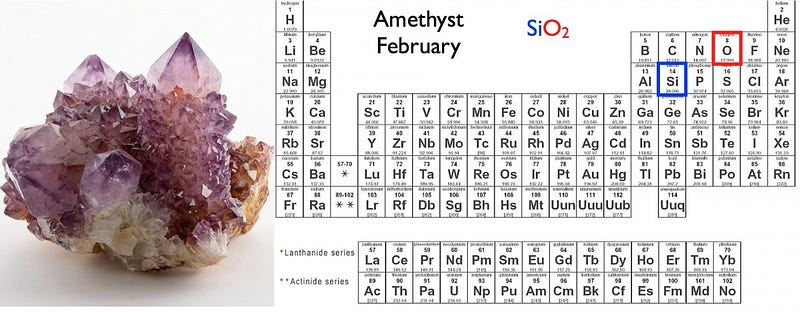
February (Amethyst): alleged to bring temperance and mental balance to the wearer, the amethyst is a simple quartz (SiO2) crystal in a 6-sized prism lattice, with iron impurities that give it a lavender, violet or even a reddish coloration. Also an igneous rock, amethysts were once considered to be as valuable as rubies, emeralds or sapphires, yet they are now known to occur commonly in the simple geode, found within volcanic rocks. They are found in great abundance in Brazil and Uruguay, and can be produced in the lab by doping quartz with iron and then irradiating it.
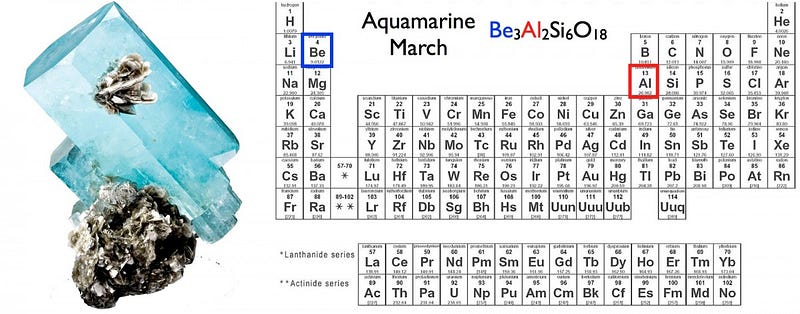
March (Aquamarine): allegedly associated with youth, health and hope, aquamarine is the most common (blue) color for the mineral beryl. The doubly ionized iron (Fe2+) impurities found in aquamarine are what give it its characteristic light blue color, while a triply ionized iron impurity (Fe3+) produce a yellow/gold color instead. When both impurities are present, you get a darker blue color known as Maxixe, where the color fades if exposed to light but returns if you irradiate it. Aquamarine comes in a hexagonal lattice, is often huge (specimens over a foot in diameter are not uncommon), and are most frequently found in granite intrusions.
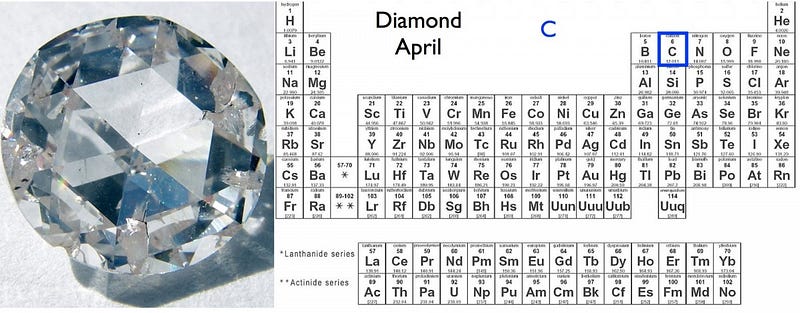
April (Diamond): allegedly associated with richness in love, diamond is ideally colorless and made out of pure carbon in an octagonal crystal lattice. Each diamond atom is tetrahedrally bonded to four neighbors, forming a face-centered-cubic structure. Contrary to popular belief, they’re not formed by applying pressure to coal, but rather by exposing carbon to extremely high pressures (45,000–60,000 times Earth’s atmosphere) but to relatively low temperatures (of “only” 900–1,300°C) simultaneously. This only occurs under two known natural conditions: in the upper portions of Earth’s mantle, requiring carbon to be “sunk” via tectonic plate subduction (and then reintroduced to the surface), or during a meteor strike.
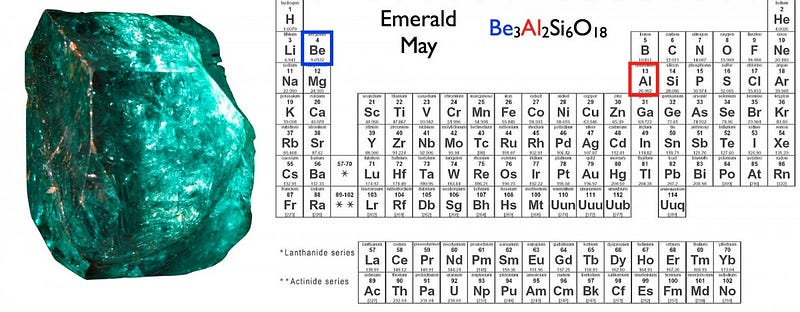
May (Emerald): allegedly associated with both love and rebirth, emeralds are very similar to aquamarine, having the same chemical formula and crystal structure. The underlying mineral, beryl, is identical, but instead of iron impurities, emerald contains either chromium or vanadium impurities which give it a green color. Most gemstones are sought to be free of inclusions, or impurities that make their way to the surface, but emeralds are almost always rich in them, making them prone to breakage. Emeralds can be found all over the world, but are most common in Colombia, which produces up to 95% of the world’s emeralds in a year.

June (Alexandrite): there’s no alleged purpose to these, perhaps because alexandrite was only first discovered in the 19th century! Alexandrite is formed when liquid magma melts beryllium and aluminum, cooling and forming an orthorhombic (eight-pointed) crystal, and is the third hardest natural crystal (behind diamonds and corundum). Alexandrite’s molecular structure — with no silicon or carbon — is very interesting, and gives it some unusual optical properties that cause its color to vary from red/violet-to-green or even orange/yellow depending on the lighting it’s exposed to.
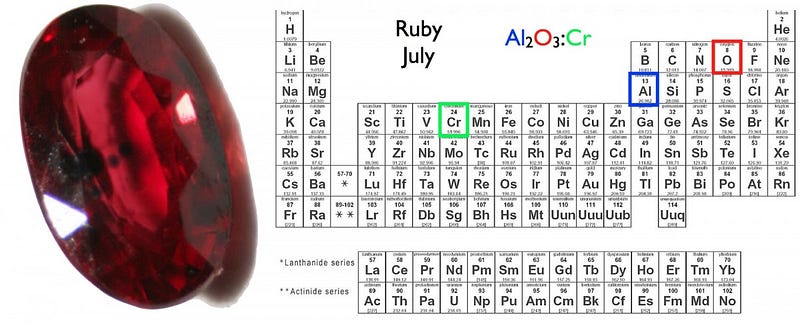
July (Ruby): allegedly associated with not only love, health and wisdom, rubies were thought to bring extreme good fortune to whomever one was gifted. In reality, ruby is a standard corundum crystal, where aluminum and oxygen ions are arranged in a trigonal crystal, but where a few of the aluminums are substituted by chromium. Each Cr3+ ion is octahedrally surrounded by six oxygen ions, causing it to absorb yellow-green light and re-emit it as red light, giving rubies their red color. Rubies are some of the hardest gemstones around, and while they can have secondary hues of many other colors, the primary hue of a corundum crystal must be red in order for it to be considered a ruby.

August (Peridot): allegedly imbuing the owner with power, influence, and magical powers to protect against nightmares, peridot is gem-quality olivine, a mineral noted for its green color. Most minerals occur in a variety of colors and hues, but peridot is always green, irrespective of whether it contains magnesium or iron (although more iron will give a darker, richer green). Although olivine is an extremely common mineral, gem-quality peridot is rare, due to the fact that it’s quite chemically unstable on the Earth’s surface. Most of the olivine found is small and heavily weathered, and olivine is relatively low on the hardness scale. Peridots are often confused with emeralds, but the latter are far more valuable!
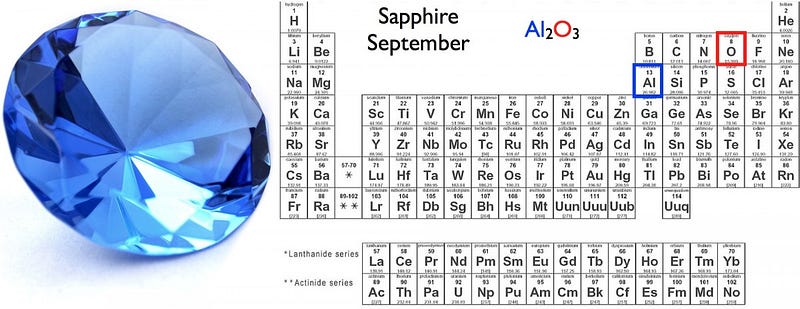
September (Sapphire): allegedly protecting those close to you and inspiring loyalty and trust, sapphires are very similar to rubies in structure. With the same trigonal crystal structure based on aluminum and oxygen, sapphires can have trace amounts of a variety of elements, including iron, titanium, copper, magnesium or even (like rubies) chromium. Just as hard but with a color otherthan red as their primary hue (most often blue), sapphires occasionally contain inclusions of titanium dioxide that leave a six-pointed streak throughout the gem. In this case, they’re known as “star sapphires,” and double-inclusions can leave a 12-pointed effect. Iron and chromium together yield the violet/blue color most sought after in a sapphire. Sapphires can be quite large, at hundreds or even over 1,000 carats.

October (Opal): alleged to bring great luck, opal is the only birthstone that isn’t a mineral, but is instead a hydrated, amorphous form of silica, containing anywhere from 3–21% water, making it a mineraloid. Rather than occurring exclusively in igneous rock or in volcanic intrusions, opal can form in any type of rock. Small, microscopic silica spheres (smaller than the wavelength of visible light) arrange themselves into a hexagonal or cubic lattice, and the way light reflects and diffracts off of them causes the intricate, multicolored patterns characteristic of opal. Opal can either have a crystalline structure or be amorphous, yet both are varied and beautiful in their appearances. Opals are the softest of all the birthstones.

November (Topaz): allegedly associated with warmth and healing, topaz is an aluminum and fluorine-based silicate mineral. Like Alexandrite, topaz is an orthorhombic crystal, which can contain a wide variety of impurities giving it a wide variety of colors, including red, yellow, gray, orange, blue, pale green, or very rarely, pink. However, the famed “mystic” topaz isn’t naturally occurring, but results from a special coating artificially applied to colorless topaz. Blue topaz, as well, is often artificial, produced by the irradiation of natural topaz.
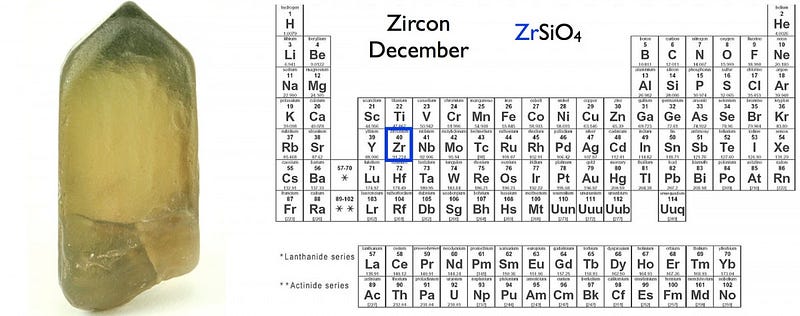
December (Zircon): allegedly associated with honor and wisdom, zircon is ubiquitous throughout the Earth’s crust, but large crystals of it are very rare. It forms a tetragonal crystal and almost always contains a significant amount (1–4%) of hafnium impurities, and occasionally even radioactive materials like uranium or thorium. While it can be colorless, impurities can give it a golden color, as well as red, brown, green, or blue, the last of which is traditionally associated with the gemstone, although naturally blue zircon is relatively rare. Some zircon crystals are among the oldest known materials on Earth, and can be dated to be more than four billion years old.
In reality, gemstones are simply minerals, and the twelve birthstone minerals have neither positive nor negative prospects for the wearer/possessor (even the radioactive ones!) other than what we bring to it with our own emotions and perceptions. However, each gemstone has a unique physical history, structure and story behind it, and the more we know about it, the more we can appreciate what the natural world truly has to offer and the less mired in superstition we can be. In the end, that’s a victory for science and for us all no matter how you slice it!
This post first appeared at Forbes. Leave your comments on our forum, check out our first book: Beyond The Galaxy, and support our Patreon campaign!





